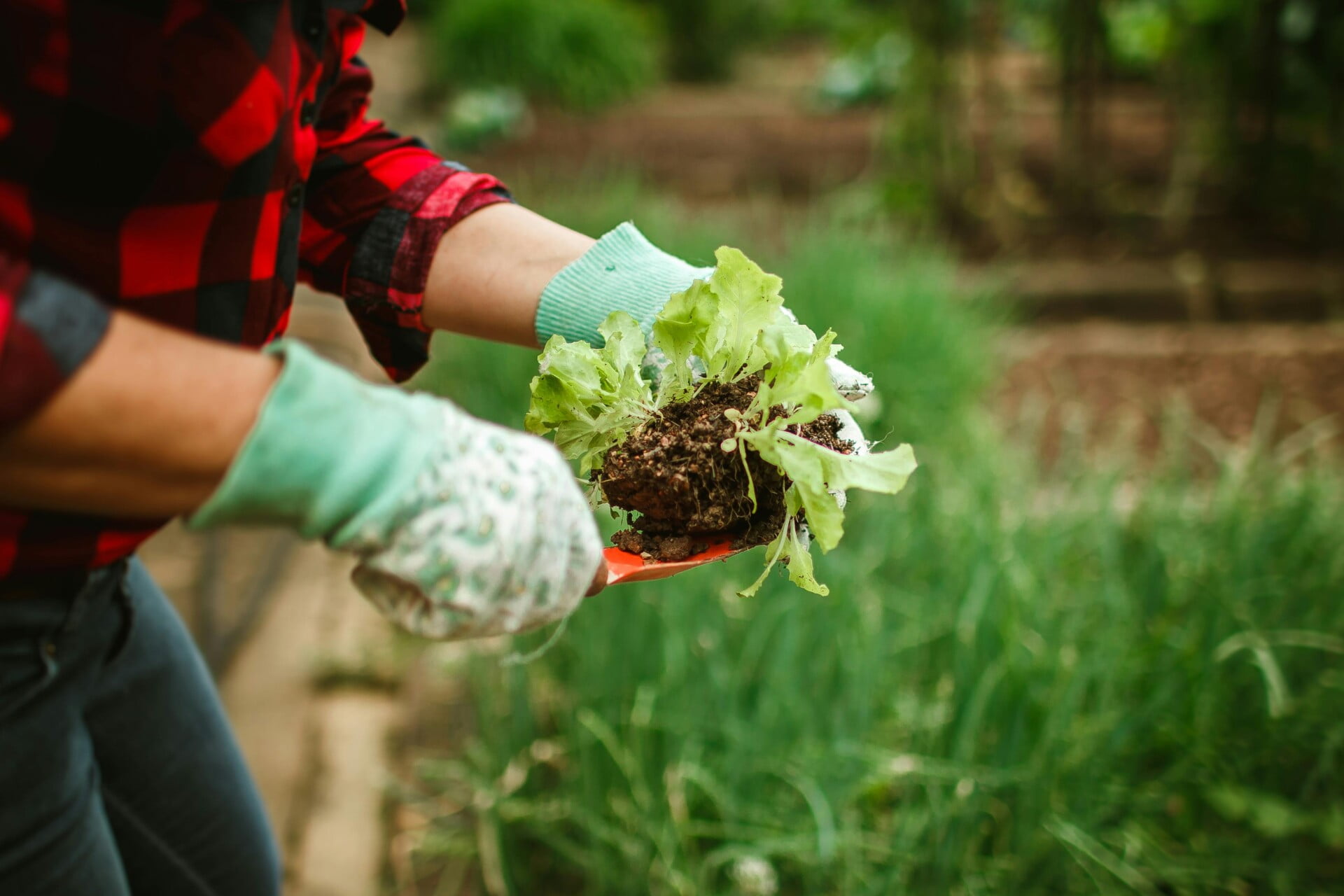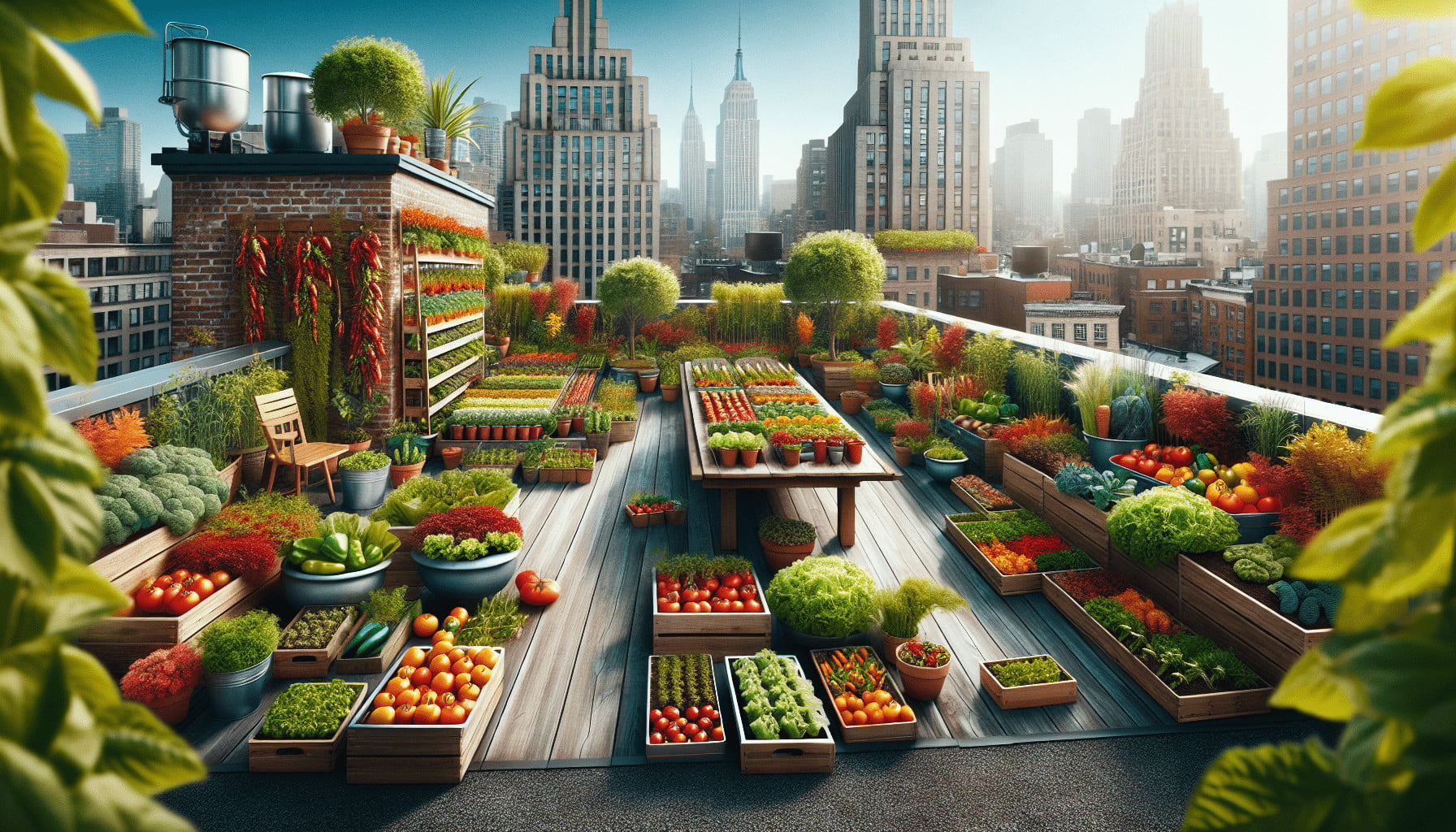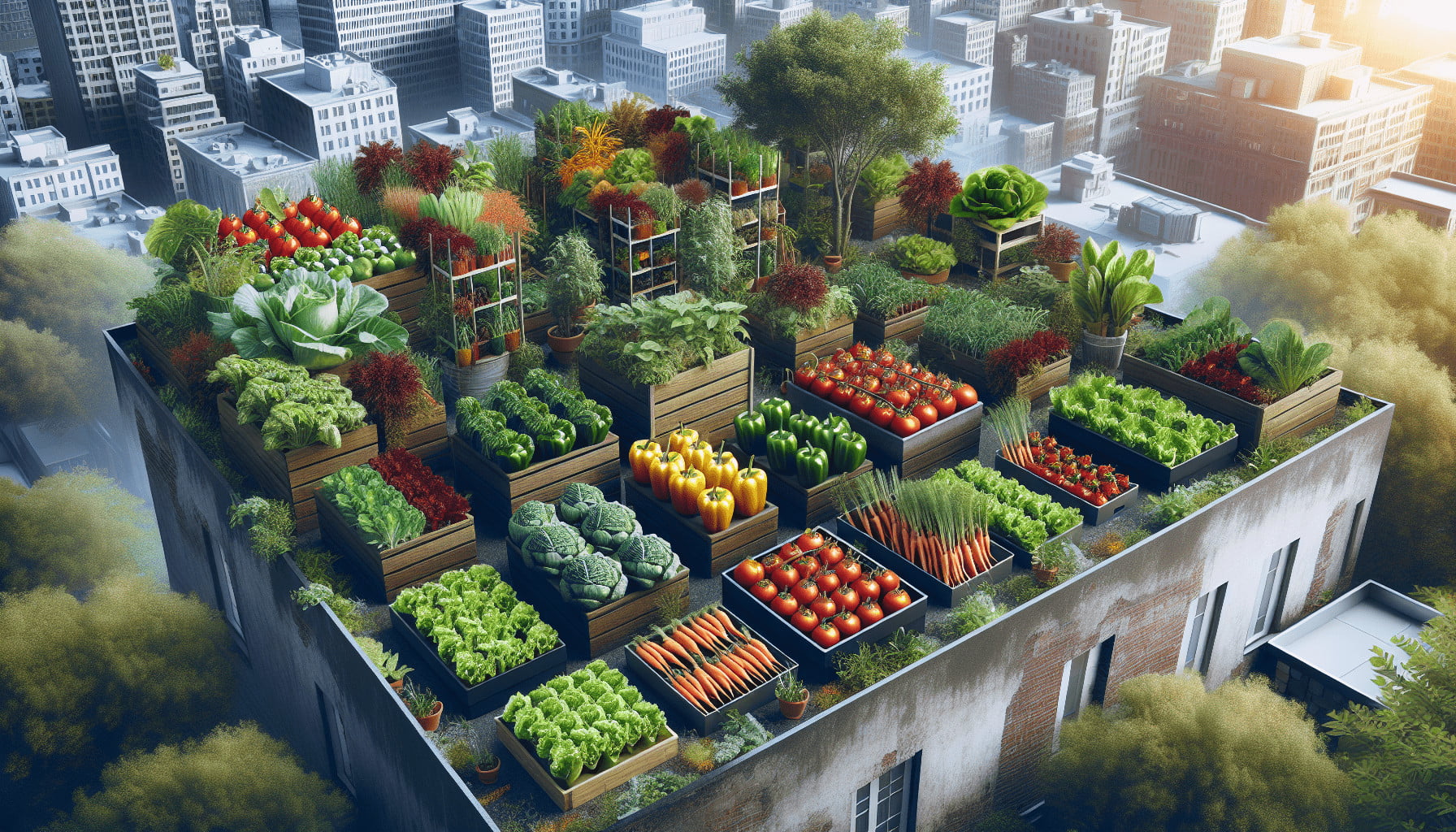In this article, we will explore the top 10 vegetables that are perfect for growing on your rooftop. From easy-to-care-for options like tomatoes and peppers, to nutrient-packed leafy greens like spinach and kale, you’ll discover how simple it can be to create your own rooftop garden. With a little bit of effort and a green thumb, you can enjoy a bountiful harvest of fresh, nutritious vegetables right outside your door. So grab your gardening gloves and get ready to transform your rooftop into a vibrant and delicious growing space! Have you ever considered growing your own vegetables right on your rooftop? Well, guess what – you can! Not only will you have access to fresh, delicious produce right at your fingertips, but rooftop gardening can also help reduce your carbon footprint and add a touch of greenery to your urban living space. In this article, we’ll explore the top 10 vegetables perfect for growing on your rooftop. So grab your gardening gloves and let’s get started!

Benefits of Rooftop Gardening
Rooftop gardening offers a myriad of benefits, including providing you with a sustainable source of fresh produce, helping to improve air quality, reducing energy costs by providing insulation, and creating a beautiful green space in your urban environment. Plus, tending to your rooftop garden can be a relaxing and rewarding experience. So why not give it a try?
Fresh, Organic Produce
Imagine the satisfaction of picking a ripe, juicy tomato or crisp, crunchy lettuce straight from your rooftop garden and incorporating it into your meals. You’ll know exactly where your food is coming from and have the peace of mind of knowing that it’s free from harmful pesticides and chemicals.
Air Quality Improvement
Plants have a natural ability to absorb carbon dioxide and release oxygen through photosynthesis, making them excellent air purifiers. By growing vegetables on your rooftop, you can help reduce air pollution in your city and create a healthier living environment for yourself and your neighbors.
Energy Savings
The plants in your rooftop garden can act as natural insulators, helping to regulate the temperature of your home and reduce your energy costs. In the summer, the plants can provide shade, cooling your home and decreasing the need for air conditioning. In the winter, they can help retain heat, reducing the amount of energy required for heating.
Aesthetically Pleasing
Rooftop gardens not only provide you with a source of fresh produce but also create a visually appealing green space in your urban environment. Whether you’re looking to add a pop of color with flowering plants or create a lush oasis with vegetables and herbs, rooftop gardening allows you to unleash your creativity and enhance the beauty of your space.
Selecting the Right Vegetables
When it comes to rooftop gardening, it’s essential to choose vegetables that are well-suited to growing in containers and have a compact growth habit. Opt for vegetables that are low maintenance, don’t require a lot of space, and can tolerate varying weather conditions. Here are some top picks for vegetables that thrive in rooftop gardens:
Lettuce
Lettuce is a versatile vegetable that can be grown in containers on your rooftop. With its shallow roots, lettuce does well in small spaces and can be easily harvested by snipping off individual leaves. Plus, you’ll have a constant supply of fresh, crisp lettuce for salads and sandwiches.
Tomatoes
Tomatoes are a rooftop gardening favorite, thanks to their delicious flavor and abundant fruit production. Choose compact varieties like cherry or grape tomatoes that are well-suited to container growing. Tomatoes require plenty of sunlight, so be sure to place them in a sunny spot on your rooftop.
Herbs
Herbs like basil, parsley, mint, and cilantro are ideal for rooftop gardens, as they don’t require a lot of space and can be grown in shallow containers. Herbs make a fantastic addition to your meals, adding flavor and freshness to your dishes. Plus, they smell wonderful and can attract beneficial pollinators to your rooftop garden.
Peppers
Peppers are another excellent vegetable for rooftop gardens, with compact varieties that are perfect for container growing. Whether you prefer sweet bell peppers or spicy jalapenos, peppers add a pop of color and flavor to your rooftop garden. Be sure to provide your pepper plants with plenty of sunlight and water to ensure a bountiful harvest.
Carrots
Carrots are a root vegetable that can be grown in containers on your rooftop with ease. Choose a deep container to accommodate the long taproots of carrots and fill it with loose, well-draining soil. With regular watering and plenty of sunlight, you’ll soon be enjoying sweet, crunchy carrots fresh from your rooftop garden.

Creating the Perfect Rooftop Garden
Now that you’ve selected the vegetables you’d like to grow on your rooftop, it’s time to create the perfect garden space. Here are some tips to help you set up your rooftop garden for success:
Assess Your Rooftop Space
Before you start planting, take a good look at your rooftop space to determine the best location for your garden. Consider factors like sunlight exposure, wind exposure, and access to water. Most vegetables require at least 6-8 hours of sunlight per day, so choose a spot that receives plenty of natural light.
Choose the Right Containers
Select containers that are large enough to accommodate the root systems of your vegetables and provide adequate drainage. Terra cotta, ceramic, or plastic pots are all good options for rooftop gardening. Be sure to place saucers under your containers to catch excess water and prevent leaks.
| Vegetable | Container Size | Watering Needs | Sunlight Requirements |
|---|---|---|---|
| Lettuce | 6-8 inches | Moderate | Partial to Full Sun |
| Tomatoes | 14-20 inches | Regular | Full Sun |
| Herbs | 4-6 inches | Moderate | Partial to Full Sun |
| Peppers | 12-16 inches | Regular | Full Sun |
| Carrots | 12-16 inches | Regular | Full Sun |
Provide Adequate Watering
Watering is key to the success of your rooftop garden, as containers tend to dry out more quickly than traditional garden beds. Check your plants regularly and water them as needed, ensuring that the soil stays consistently moist but not waterlogged. Consider investing in a drip irrigation system to make watering more efficient.
Create a Support System
Some vegetables, like tomatoes and peppers, may require a support system to help them grow upright and produce abundant fruit. Use tomato cages, trellises, or stakes to provide support for your plants and prevent them from toppling over as they grow.
Implement Pest Control Measures
Keep an eye out for common garden pests like aphids, caterpillars, and slugs that may damage your rooftop vegetables. Encourage natural predators like ladybugs and lacewings to help keep pest populations in check, and consider using organic pest control methods like neem oil or insecticidal soap.

Harvesting Your Bounty
One of the most rewarding aspects of rooftop gardening is harvesting the fruits of your labor. When your vegetables are ready to be picked, be sure to do so at the peak of ripeness for the best flavor and nutritional value. Here are some tips for harvesting your rooftop garden produce:
Lettuce
Harvest lettuce by snipping off individual leaves at the base of the plant, allowing the remaining leaves to continue growing. This method of harvesting, known as cut-and-come-again, allows you to enjoy a continuous supply of fresh lettuce throughout the growing season.
Tomatoes
When tomatoes are fully ripe, they should have a firm texture and vibrant color. Gently twist the tomato off the vine or use a pair of sharp scissors to avoid damaging the plant. Store your tomatoes at room temperature until they reach your desired ripeness, then enjoy them fresh or incorporate them into your favorite recipes.
Herbs
Harvest herbs by snipping off the top few inches of growth, just above a pair of leaves. Regularly pruning your herbs will encourage bushy growth and help to prolong the life of the plant. Fresh herbs can be used immediately or dried for long-term storage.
Peppers
Peppers can be harvested once they reach their mature size and color. Use a pair of sharp scissors or pruning shears to cut the peppers from the plant, being careful not to damage the stems or branches. Peppers can be enjoyed fresh, roasted, grilled, or preserved through pickling or canning.
Carrots
Harvest carrots when they reach a mature size, typically 1-2 inches in diameter. Gently loosen the soil around the base of the carrot and pull it out of the ground by the greens, being careful not to break the roots. Rinse your carrots clean and enjoy them raw, roasted, or incorporated into your favorite dishes.

Maintaining Your Rooftop Garden
To ensure the long-term success of your rooftop garden, it’s important to maintain your plants and make adjustments as needed. Here are some tips for caring for your rooftop garden throughout the growing season:
Regularly Monitor Soil Moisture
Check the moisture level of your soil regularly and water your plants as needed. Avoid overwatering, as this can lead to root rot, and under-watering, which can cause your plants to wilt and become stressed. Consider using a soil moisture meter to help you determine when to water.
Fertilize Your Plants
Feed your rooftop garden with a balanced fertilizer to provide essential nutrients for healthy growth and development. Choose a slow-release organic fertilizer or a water-soluble fertilizer to ensure that your plants receive the nutrients they need throughout the growing season. Follow the manufacturer’s instructions for application rates and frequency.
Prune and Trim Plants
Regularly prune and trim your plants to remove dead or damaged foliage, encourage new growth, and improve air circulation. Use clean, sharp pruning shears to make clean cuts and prevent the spread of disease. Pruning can also help to control the size and shape of your plants, ensuring that they don’t become overcrowded.
Rotate Your Crops
To prevent soil depletion and reduce the risk of disease, practice crop rotation in your rooftop garden. Planting different vegetables in the same containers each season can help to replenish soil nutrients and disrupt pest cycles. Rotate your crops annually to maintain soil fertility and promote healthy plant growth.
Protect Your Garden from Extreme Weather
Be prepared to protect your rooftop garden from extreme weather conditions like high winds, heavy rain, or intense heat. Consider using windbreaks, shade cloth, or row covers to shield your plants from harsh weather and prevent damage. Monitor weather forecasts and take proactive measures to safeguard your garden.

Conclusion
Rooftop gardening offers a unique opportunity to grow your own fresh, organic vegetables right at home. With the right selection of vegetables, proper care and maintenance, you can create a thriving rooftop garden that provides you with a bountiful harvest of delicious produce. So why not take advantage of your rooftop space and start growing your own vegetables today? Happy gardening!
